You may remember the startling report about 15 years ago by Morley Safer on ’60 Minutes’ regarding the ‘The French Paradox?’ The French were able to consume a high fat diet, yet had a much lower risk of coronary heart disease than a typical American would experience. The reason for this paradox was perceived to be the French population’s higher level of red wine consumption.
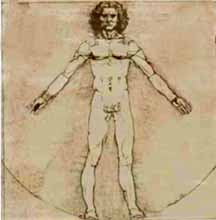
According to the relatively conservative American Heart Association, research is being done to find out what the apparent benefits of drinking wine or alcohol in some populations may be due to, including the role of antioxidants, an increase in HDL ("good") cholesterol or anti-clotting properties. “Clinical trials of other antioxidants such as vitamin E have not shown any cardio-protective effect. Also, even if they were protective, antioxidants can be obtained from many fruits and vegetables, including red grape juice. The best-known effect of alcohol is a small increase in HDL cholesterol. However, regular physical activity is another effective way to raise HDL cholesterol, and niacin can be prescribed to raise it to a greater degree. Alcohol or some substances such as resveratrol found in alcoholic beverages may prevent platelets in the blood from sticking together.” On my last physical, my HDL level was 92 with the LDL being 88 (total cholesterol of 180). My doctor said that this was the first time that he had seen a higher HDL than LDL (bad cholesterol) where LDL is typically around 3x HDL. Another doctor friend of mine who previously did research in labs said that red wine is partially to receive the credit here, but the fact that I regularly exercise contributed as well.
Alzheimer's
According to new animal research, drinking red wine may help prevent Alzheimer's disease. In a research study, mice that were given cabernet sauvignon experienced significantly reduced Alzheimer's disease-type brain deterioration of memory function compared to mice that received ethanol or water.
The researchers, from Mount Sinai School of Medicine in New York, found that cabernet sauvignon's benefits were due to its ability to prevent the generation of proteins that cause plaque buildup in the brain, which is the main characteristic of Alzheimer's disease. "This study supports epidemiological evidence indicating that moderate wine consumption, defined as one drink per day for women and two for men, may help reduce the relative risk for AD clinical dementia," said researchers Dr. Giulio Maria Pasinetti and Dr. Jun Wang.
Diabetes
For humans, high calorie diets can increase glucose and insulin levels leading to diabetes, cardiovascular disease, and non-alcoholic fatty liver disease. In the Harvard study, researchers found biomarkers that might predict diabetes, including increased levels of insulin, glucose and insulin-like growth factor-1 in the non-resveratrol fed mice. For example, a standard diabetes glucose test on the resveratrol fed group found considerably higher insulin sensitivity, meaning the resveratrol group had a lower disposition toward diabetes than the non-resveratrol fed group. Lower insulin levels predicted increased lifespans in the mice. This is a tough prevention/cure dilemma as many doctors suggest their diabetic patients to stay away from wine due to wine’s natural grape sugars. It is best to consult your physician with any questions here.
Heart and Liver
In the Harvard study, researchers found that the livers of mice at 18 months of age on the non-resveratrol diet were greatly increased in size and weight. Liver tissue studies of these mice showed a loss of cellular integrity, and a build-up of lipids, which is common to high fat diets. In contrast, the resveratrol group had normal, healthy livers.
Immune System
Unlike many other alcoholic beverages, red wine does not suppress the immune system, according to preliminary studies at the University of Florida. While red wine has been reported to aid in the prevention of coronary heart disease and some cancers, no one had studied whether its alcohol content might offset any benefits, said food science and human nutrition researcher Susan Percival.
Percival, who specializes in nutrition and immunity, conducted a study to find out if red wine affects the immune system. Her research shows that the circulating white blood cells that fight infection are neither helped nor hurt by red wine. The study was designed to replicate moderate alcohol consumption for people, so the mice were given the equivalent of two or three glasses, or servings, of wine or alcohol per day.
Moderation
It is important to stress that this blog is neither condoning nor encouraging the consumption of alcohol. Over consumption of ethanol (alcohol) has shown itself to be more harmful than beneficial as will be explained below by the “J shaped curve.” Please note though that other benefits of moderate consumption that have been researched but not covered here are ethanol’s role in the prevention against strokes and in increased bone density in the elderly.

J Shaped Curve
OK, take a large population of people with the knowledge of their average daily alcohol consumption, and their mortality. Plot the mortality on the upright axis, and on the horizontal axis take alcohol average daily consumption. Now fit a curve to the data points. If you have a large enough population, you'll see a nice curve that has the shape of a J. That is, those who drink nothing, have what is estimated to be a baseline mortality, or the risk of death used as a reference point. As daily consumption increases, that risk of death drops slightly. Then, as alcohol consumption increases, the risk of death increases until it reaches the baseline (these people have the same risk of death as those who drink nothing at all), and as drinking gets heavier, the risk of death continues to increase steadily. This is called the J-shaped curve, and is a remarkably consistent finding from many large studies. It is the solid body of data that has led to the conclusion that moderate drinking is indeed beneficial to health. Yet, over-consumption will reduce the benefits and actually have negative consequences.
Resveratrol in Wine
When resveratrol data first began coming out around ten years ago, many presumed it would be the red grapes with the thickest skins that would contain the highest concentrations of resveratrol since resveratrol is found in the skins. Turns out that the thicker skinned varieties such as Cabernet Sauvignon, produce less resveratrol than thin skinned varieties such as Pinot Noir, as they have less stress protecting themselves against moulds and vineyard pests. ‘As if’ Pinot Noir needs another reason for us to drink it? We at WW have a terrific selection of Pinot Noirs in that are worth trying from Burgundy in France and other areas around the world. Ask your store manager for their favorites. You may want to try:
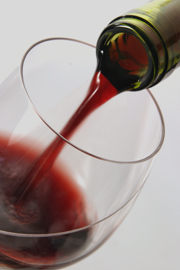
Burgundy
Colin Bourgogne Rouge 2004, Retail $18.99 Warehouse $15.99
Colin Maranges ‘Fussieres’ 2004, Retail $34.99 Warehouse $26.99
Bertheau Chambolle Musigny ‘Premier Cru’ 2004, Retail $69.99 Warehouse $49.99
Boillot Gevrey Chambertin ‘Cherbaudes’ 2004, Retail $59.99 Warehouse $51.99
California
Avila Pinot Noir 2005, Retail $14.99 Warehouse $10.99
Lily Pinot Noir 2005, Retail $21.99 Warehouse $17.99
Laetitia Pinot Noir 2005, Retail $24.99 Warehouse $19.99
New Zealand (coming soon) please look for these as well as our current in-store selections
Villa Maria ‘Cellar Selection’ Marlborough 2005
Vidal ‘Marlborough’ 2004
Rockburn ‘Central Otago’ 2003 which is a 90 pointer in the Wine Spectator
Winery Feature: Falesco from Umbria in Italy
Recently, a study co-authored by researchers from Harvard University and the National Institutes of Health that found that resveratrol, a substance found in red wine, extended the life and improved the health of middle-aged, overweight mice. Why should we care about resveratrol or obese mice? Resveratrol is found in red wines and also produced by a variety of plants (including vines) when put under stress.
Resveratrol appears to be associated with anti-aging and preventing the effects of diseases of aging, such as diabetes, cancer and dementia. Using a high calorie diet on mice, researchers found that among the overweight mice, giving a control group resveratrol reduced the negative impact of being obese. When the mice were 60 weeks old, those mice receiving resveratrol showed a three- to four-month increase in survival, compared to mice not receiving the compound. By 114 weeks, when the mice reached old age, more than half of the animals on a high-fat diet alone had died, compared to less than one-third of those receiving resveratrol. "Resveratrol extends the lifespan of every species we have fed it to," said lead researcher David Sinclair, an associate professor of pathology at Harvard Medical School. "We are now showing that this is also possible for mice on a high-fat diet," he added. Resveratrol is said to stabilize blood sugar and other effects of obesity. Astoundingly, the organs of the fat mice that got the wine extract looked normal when they shouldn’t have, said study lead author Dr. David Sinclair of Harvard Medical School. And Sinclair said other preliminary work still being done in the lab shows the wine ingredient has promise in lengthening the life span of normal-sized mice, too. The resveratrol-treated 55 obese mice on a high-calorie diet (one scientist called it a “McDonald’s diet”) are not only about as healthy as normal mice, they are as agile and active on exercise equipment as their lean cousins, showing what can be considered a normal quality of life, higher than usual for obese mice, said study co-author Rafael de Cabo of the National Institute on Aging.
Heart Disease
Over the past several decades, many studies have been published in scientific journals about how drinking alcohol may be associated with reduced mortality due to heart disease in some populations. Some researchers have suggested that the benefit may be due to wine, especially red wine. Others are examining the potential benefits of components in red wine such as flavonoids and other antioxidants in reducing heart disease risk. Some of these components may be found in other foods such as grapes or red grape juice. The linkage reported in many of these studies may be due to other lifestyle factors rather than alcohol. Such factors may include increased physical activity, and a diet high in fruits and vegetables and lower in saturated fats.
Resveratrol appears to be associated with anti-aging and preventing the effects of diseases of aging, such as diabetes, cancer and dementia. Using a high calorie diet on mice, researchers found that among the overweight mice, giving a control group resveratrol reduced the negative impact of being obese. When the mice were 60 weeks old, those mice receiving resveratrol showed a three- to four-month increase in survival, compared to mice not receiving the compound. By 114 weeks, when the mice reached old age, more than half of the animals on a high-fat diet alone had died, compared to less than one-third of those receiving resveratrol. "Resveratrol extends the lifespan of every species we have fed it to," said lead researcher David Sinclair, an associate professor of pathology at Harvard Medical School. "We are now showing that this is also possible for mice on a high-fat diet," he added. Resveratrol is said to stabilize blood sugar and other effects of obesity. Astoundingly, the organs of the fat mice that got the wine extract looked normal when they shouldn’t have, said study lead author Dr. David Sinclair of Harvard Medical School. And Sinclair said other preliminary work still being done in the lab shows the wine ingredient has promise in lengthening the life span of normal-sized mice, too. The resveratrol-treated 55 obese mice on a high-calorie diet (one scientist called it a “McDonald’s diet”) are not only about as healthy as normal mice, they are as agile and active on exercise equipment as their lean cousins, showing what can be considered a normal quality of life, higher than usual for obese mice, said study co-author Rafael de Cabo of the National Institute on Aging.
Heart Disease
Over the past several decades, many studies have been published in scientific journals about how drinking alcohol may be associated with reduced mortality due to heart disease in some populations. Some researchers have suggested that the benefit may be due to wine, especially red wine. Others are examining the potential benefits of components in red wine such as flavonoids and other antioxidants in reducing heart disease risk. Some of these components may be found in other foods such as grapes or red grape juice. The linkage reported in many of these studies may be due to other lifestyle factors rather than alcohol. Such factors may include increased physical activity, and a diet high in fruits and vegetables and lower in saturated fats.

According to the relatively conservative American Heart Association, research is being done to find out what the apparent benefits of drinking wine or alcohol in some populations may be due to, including the role of antioxidants, an increase in HDL ("good") cholesterol or anti-clotting properties. “Clinical trials of other antioxidants such as vitamin E have not shown any cardio-protective effect. Also, even if they were protective, antioxidants can be obtained from many fruits and vegetables, including red grape juice. The best-known effect of alcohol is a small increase in HDL cholesterol. However, regular physical activity is another effective way to raise HDL cholesterol, and niacin can be prescribed to raise it to a greater degree. Alcohol or some substances such as resveratrol found in alcoholic beverages may prevent platelets in the blood from sticking together.” On my last physical, my HDL level was 92 with the LDL being 88 (total cholesterol of 180). My doctor said that this was the first time that he had seen a higher HDL than LDL (bad cholesterol) where LDL is typically around 3x HDL. Another doctor friend of mine who previously did research in labs said that red wine is partially to receive the credit here, but the fact that I regularly exercise contributed as well.
Alzheimer's
According to new animal research, drinking red wine may help prevent Alzheimer's disease. In a research study, mice that were given cabernet sauvignon experienced significantly reduced Alzheimer's disease-type brain deterioration of memory function compared to mice that received ethanol or water.
The researchers, from Mount Sinai School of Medicine in New York, found that cabernet sauvignon's benefits were due to its ability to prevent the generation of proteins that cause plaque buildup in the brain, which is the main characteristic of Alzheimer's disease. "This study supports epidemiological evidence indicating that moderate wine consumption, defined as one drink per day for women and two for men, may help reduce the relative risk for AD clinical dementia," said researchers Dr. Giulio Maria Pasinetti and Dr. Jun Wang.
Diabetes
For humans, high calorie diets can increase glucose and insulin levels leading to diabetes, cardiovascular disease, and non-alcoholic fatty liver disease. In the Harvard study, researchers found biomarkers that might predict diabetes, including increased levels of insulin, glucose and insulin-like growth factor-1 in the non-resveratrol fed mice. For example, a standard diabetes glucose test on the resveratrol fed group found considerably higher insulin sensitivity, meaning the resveratrol group had a lower disposition toward diabetes than the non-resveratrol fed group. Lower insulin levels predicted increased lifespans in the mice. This is a tough prevention/cure dilemma as many doctors suggest their diabetic patients to stay away from wine due to wine’s natural grape sugars. It is best to consult your physician with any questions here.
Heart and Liver
In the Harvard study, researchers found that the livers of mice at 18 months of age on the non-resveratrol diet were greatly increased in size and weight. Liver tissue studies of these mice showed a loss of cellular integrity, and a build-up of lipids, which is common to high fat diets. In contrast, the resveratrol group had normal, healthy livers.
Immune System
Unlike many other alcoholic beverages, red wine does not suppress the immune system, according to preliminary studies at the University of Florida. While red wine has been reported to aid in the prevention of coronary heart disease and some cancers, no one had studied whether its alcohol content might offset any benefits, said food science and human nutrition researcher Susan Percival.
Percival, who specializes in nutrition and immunity, conducted a study to find out if red wine affects the immune system. Her research shows that the circulating white blood cells that fight infection are neither helped nor hurt by red wine. The study was designed to replicate moderate alcohol consumption for people, so the mice were given the equivalent of two or three glasses, or servings, of wine or alcohol per day.
Moderation
It is important to stress that this blog is neither condoning nor encouraging the consumption of alcohol. Over consumption of ethanol (alcohol) has shown itself to be more harmful than beneficial as will be explained below by the “J shaped curve.” Please note though that other benefits of moderate consumption that have been researched but not covered here are ethanol’s role in the prevention against strokes and in increased bone density in the elderly.

J Shaped Curve
OK, take a large population of people with the knowledge of their average daily alcohol consumption, and their mortality. Plot the mortality on the upright axis, and on the horizontal axis take alcohol average daily consumption. Now fit a curve to the data points. If you have a large enough population, you'll see a nice curve that has the shape of a J. That is, those who drink nothing, have what is estimated to be a baseline mortality, or the risk of death used as a reference point. As daily consumption increases, that risk of death drops slightly. Then, as alcohol consumption increases, the risk of death increases until it reaches the baseline (these people have the same risk of death as those who drink nothing at all), and as drinking gets heavier, the risk of death continues to increase steadily. This is called the J-shaped curve, and is a remarkably consistent finding from many large studies. It is the solid body of data that has led to the conclusion that moderate drinking is indeed beneficial to health. Yet, over-consumption will reduce the benefits and actually have negative consequences.
Resveratrol in Wine
When resveratrol data first began coming out around ten years ago, many presumed it would be the red grapes with the thickest skins that would contain the highest concentrations of resveratrol since resveratrol is found in the skins. Turns out that the thicker skinned varieties such as Cabernet Sauvignon, produce less resveratrol than thin skinned varieties such as Pinot Noir, as they have less stress protecting themselves against moulds and vineyard pests. ‘As if’ Pinot Noir needs another reason for us to drink it? We at WW have a terrific selection of Pinot Noirs in that are worth trying from Burgundy in France and other areas around the world. Ask your store manager for their favorites. You may want to try:

Burgundy
Colin Bourgogne Rouge 2004, Retail $18.99 Warehouse $15.99
Colin Maranges ‘Fussieres’ 2004, Retail $34.99 Warehouse $26.99
Bertheau Chambolle Musigny ‘Premier Cru’ 2004, Retail $69.99 Warehouse $49.99
Boillot Gevrey Chambertin ‘Cherbaudes’ 2004, Retail $59.99 Warehouse $51.99
California
Avila Pinot Noir 2005, Retail $14.99 Warehouse $10.99
Lily Pinot Noir 2005, Retail $21.99 Warehouse $17.99
Laetitia Pinot Noir 2005, Retail $24.99 Warehouse $19.99
New Zealand (coming soon) please look for these as well as our current in-store selections
Villa Maria ‘Cellar Selection’ Marlborough 2005
Vidal ‘Marlborough’ 2004
Rockburn ‘Central Otago’ 2003 which is a 90 pointer in the Wine Spectator
Winery Feature: Falesco from Umbria in Italy
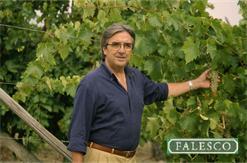
Falesco was established in 1979 with the principal aim of rediscovering and enhancing the value of Lazio’s traditional varietals. The winery is the brainchild of Italian wine-making icon Riccardo Cotarella. Falesco is located 50 miles from Rome and its vineyards are situated in the most prestigious areas around the Umbrian-Lazian border.
Est Est Est is straw yellow in color, fresh and structured because of a good level of acidity. Displays floral and fruity notes. Refreshing when served as an aperitif or with appetizers and fish dishes. Produced from 60% Trebbiano, 30% Malvasia, 10% Roscetto
Falesco Est Est Est 2005, Retail $9.99 Warehouse $6.99
Ferentano is produced from 100% Roscetto grown in estate vineyards in Montefiascone. Wine Advocate 90 points."It begins slowly aromatically, but builds intensity in the mouth revealing a tremendous, full-bodied, layered, honey character reminiscent of a southern Rhone blend of Roussanne, Viognier, and Marsanne. It could be served with meat dishes given its full body and intensity. This noteworthy value represents a remarkable achievement for this estate."
Falesco Ferentano 2004, Retail $24.99 Warehouse $19.99
Vitiano Bianco was born from one of the many experimental vineyards of the University of Viterbo. The grapes Vermentino, Viognier and Verdicchio all fair exceptionally well in the sediment and calcareous clay soils around the Marciliano estate. This white wine is nicely balanced, full and fresh while displaying characters of fresh grass, lime and ripe pears.
Falesco Vitiano Bianco 2005, Retail $10.99 Warehouse $7.99
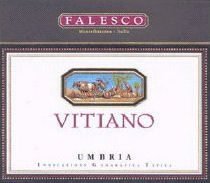
Vitiano Rosso is blend of equal parts Merlot, Cabernet Sauvignon and Sangiovese grapes grown in the region of Umbria. This is a young red wine with explosive, luscious aromas. Always a favorite at the Wine Warehouse. Wine Advocate ’89 points.’ “A rich bouquet of black cherry jam, licorice, tobacco leaf, and spice box, surprising density, and medium body. As I have written before, it’s almost too good to believe at this price.”
Falesco Vitiano Rosso 2005, Retail $10.99 Warehouse $7.99
Montiano is produced from 100% Merlot grown in the Montiano vineyard in Lazio. Montiano has a wonderful deep, ruby red color and a wide range of aromas such as vanilla and small red fruits with layers of jam and sweet spices. It is full-bodied, round and soft on the palate with an elegant and lingering finish.
Falesco Montiano, Retail $49.99 Warehouse $39.99
Falesco Montiano 375ml, Retail$24.99 Warehouse $19.99
The Merlot Pesano is produced from 100% Merlot grown in varied estate vineyards in Umbria. This Merlot is unfiltered and exhibits a deep ruby-red color and rich, spicy aromas. Wine Advocate 90 points. "An extremely intense, amazing bargain, the Merlot Pesano (100% Merlot aged 5-6 months in barrel) exhibits a deep ruby/purple hue, and fleshy, concentrated, black cherry, cassis, smoke, herb, and mocha aromas and flavors. This medium-bodied, concentrated, unbelievably low-priced red is too good to be true."
Falesco Merlot Pesano, Retail $17.99 Warehouse $14.99
Marciliano is produced from 70% Cabernet Sauvignon and 30% Cabernet Franc grown in estate vineyards in Umbria. Marciliano has a profound dark purple color and exhibits complex aromas of tobacco and slate. This wine is a great representation of Cabernet when all of nature's forces are working together. This is Umbria’s version of a ‘Super Tuscan.’
Falesco Marciliano 2003, Retail $59.99 Warehouse $49.99
Speaking of healthy, please don’t forget our fantastic selection of Estate Grown olive oils from Italy including:
Falesco Olive Oil 500ml, Retail $18.99 Warehouse $14.99
Falesco Olive Oil Marciliano 500ml, Retail $29.99 Warehouse $19.99
Sante from the blogsphere…………………
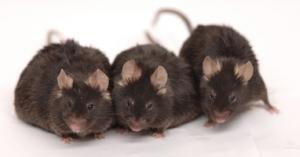


No comments:
Post a Comment